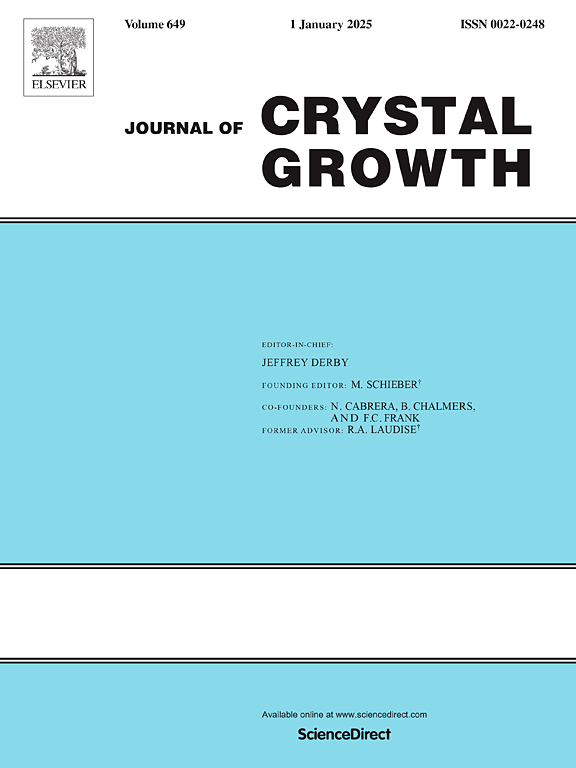An assessment of germane and tin tetrachloride for GeSn epitaxy
IF 1.7
4区 材料科学
Q3 CRYSTALLOGRAPHY
引用次数: 0
Abstract
We have screened at 325 °C chamber pressures, precursor flows and H2 carrier flows to overcome some of the limitations encountered when growing GeSn layers with a GeH4 + SnCl4 + H2 chemistry (e.g. a reduced Sn content compared to Ge2H6, a definite lack of uniformity at 400 Torr and so on). Layers grown at 300 Torr and 400 Torr were smooth and of high crystalline quality provided that GeH4 and SnCl4 flows were high and low enough, respectively. Meanwhile, layers grown at 100 Torr and 200 Torr were milky and of lesser quality. The best tradeoff in terms of GeSn growth rates, Sn contents and layer uniformity, which was vastly improved, was reached at 300 Torr. A halving of the H2 carrier flow yielded even higher growth rates and Sn concentrations. Over the 301 °C–349 °C range, we succeeded in depositing, at 300 Torr, layers with growth rates that were similar to that with our reference Ge2H6 + SnCl4 process (at 100 Torr). Activation energies associated to the growth rate increase with the temperature were slightly higher with GeH4 than with Ge2H6 (12–13 kcal. mol.−1 versus 10 kcal. mol.−1). Meanwhile, Sn contents did not drop as fast, as the temperature increased, with GeH4 than with Ge2H6 (−1.1 %/10 °C versus −1.6 %/10 °C slopes). The highest Sn content achievable with our curent GeH4 process conditions was otherwise not as high than with Ge2H6, however (10.3 % versus 14.2 %). Switching to temperatures lower than 301 °C to reach even higher Sn contents was unfortunately not an option with our current GeH4 + SnCl4 + H2 process, as layers were islanded, then.
锗和四氯化锡用于GeSn外延的评价
我们在325°C的腔室压力、前驱体流和H2载流子流下进行了筛选,以克服用GeH4 + SnCl4 + H2化学生长GeSn层时遇到的一些限制(例如,与Ge2H6相比,Sn含量降低,在400 Torr时明显缺乏均匀性等等)。当GeH4和SnCl4流动足够大和足够低时,在300和400 Torr下生长的层光滑且具有高结晶质量。同时,在100托和200托条件下生长的层呈乳白色,质量较差。在gsn生长率、Sn含量和层的均匀性方面,在300 Torr时达到了最好的平衡,大大提高了gsn的生长率。H2载流子流量减半会产生更高的生长速率和Sn浓度。在301°C - 349°C范围内,我们成功地在300 Torr下沉积了生长速率与参考Ge2H6 + SnCl4工艺(100 Torr)相似的层。随着温度的升高,GeH4比Ge2H6的活化能略高(12-13 kcal. mol.−1比10 kcal. mol.−1)。同时,随着温度的升高,GeH4的Sn含量下降的速度不如Ge2H6快(- 1.1% /10°C比- 1.6% /10°C)。然而,在我们目前的GeH4工艺条件下可以实现的最高Sn含量没有Ge2H6高(10.3%对14.2%)。不幸的是,对于我们目前的GeH4 + SnCl4 + H2工艺,切换到低于301°C的温度以达到更高的Sn含量是不可能的,因为层是孤岛的。
本文章由计算机程序翻译,如有差异,请以英文原文为准。
求助全文
约1分钟内获得全文
求助全文
来源期刊

Journal of Crystal Growth
化学-晶体学
CiteScore
3.60
自引率
11.10%
发文量
373
审稿时长
65 days
期刊介绍:
The journal offers a common reference and publication source for workers engaged in research on the experimental and theoretical aspects of crystal growth and its applications, e.g. in devices. Experimental and theoretical contributions are published in the following fields: theory of nucleation and growth, molecular kinetics and transport phenomena, crystallization in viscous media such as polymers and glasses; crystal growth of metals, minerals, semiconductors, superconductors, magnetics, inorganic, organic and biological substances in bulk or as thin films; molecular beam epitaxy, chemical vapor deposition, growth of III-V and II-VI and other semiconductors; characterization of single crystals by physical and chemical methods; apparatus, instrumentation and techniques for crystal growth, and purification methods; multilayer heterostructures and their characterisation with an emphasis on crystal growth and epitaxial aspects of electronic materials. A special feature of the journal is the periodic inclusion of proceedings of symposia and conferences on relevant aspects of crystal growth.
 求助内容:
求助内容: 应助结果提醒方式:
应助结果提醒方式:


